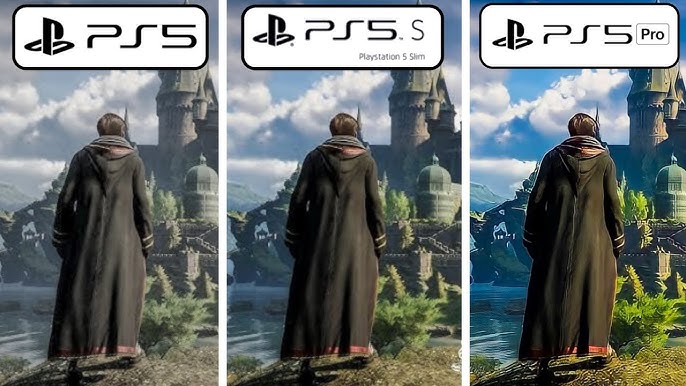So: Playstation vs Playstation Pro. What should we think of it, after all? In recent years, it has become common for tech companies to release standard versions of their products, only to follow them up with enhanced “Pro” versions later on.
This trend can be seen across various industries – from smartphones to computers, in fact. For instance, Apple frequently releases iPhones and MacBooks in standard and Pro models, offering better performance and features for users who want more power.
The same approach lately has been adopted in the video game console industry, where companies like Sony release more powerful versions of their consoles. This brings us to the focus of this article: PlayStation vs PlayStation Pro. Let’s explore how these versions differ and which one might be the right choice for you.
PlayStation vs PlayStation Pro: where did it begin?
It all started with the PlayStation 4 Pro back in 2016 – when it came as an upgrade to the original PlayStation 4, which had already been on the market for a few years. The PS4 Pro was introduced to meet the growing demand for higher-resolution gaming, particularly as 4K TVs became more popular.
The PS4 Pro was not a completely new console, but rather an enhanced version of the PS4, featuring more powerful hardware. The most notable upgrade was the improved graphics processing unit (GPU), which allowed the console to render games at 4K resolution and provide better frame rates. Additionally, it included more power to handle advanced visual effects and smoother gameplay, especially in games that were optimized for the Pro model.

While the PlayStation 4 Pro was not necessary for every gamer, it was a popular choice for those who wanted to take full advantage of the latest gaming technology, especially in terms of graphics.
PlayStation vs PlayStation Pro
The debate between PlayStation vs PlayStation Pro is primarily centered around hardware capabilities and gaming performance. For both the PS4 and the PS4 Pro, as well as future PlayStation models, the Pro versions are designed to deliver a superior gaming experience. But what exactly sets them apart?
Graphics and resolution
One of the most significant differences between the standard PlayStation and the Pro version is the graphical output. The Pro models, like the PS4 Pro, offer higher resolutions and better visual fidelity, thanks to a more powerful GPU. This means that games will look sharper and more detailed, particularly on 4K displays. On the other hand, the standard PlayStation models typically offer full HD (1080p) resolution, which is still quite good for most gamers but lacks the sharpness of 4K.
Performance
Another key difference in the PlayStation vs PlayStation Pro comparison is the overall performance. The Pro models have enhanced processors that allow them to handle more demanding games and provide smoother frame rates. For example, some games that struggle to maintain a stable 30 frames per second (fps) on the standard PlayStation can run at 60 fps on the Pro version, providing a much more fluid and enjoyable gaming experience.
Storage and features
Pro models often come with more storage capacity, allowing gamers to install more games and media. Additionally, PlayStation Pro models may feature enhanced capabilities such as improved virtual reality (VR) support, better cooling systems to prevent overheating, and faster loading times due to more advanced hardware.

What changes between PS5 and PS5 Pro?
As of now, Sony has not officially released a PlayStation 5 Pro (PS5 Pro), but its launch date is set for November 7th, 2024. The PS5 has already set a high standard for gaming performance with its powerful hardware, and this Pro version will offer even more advancements.
When comparing the PlayStation vs PlayStation Pro for the PS5 generation, potential upgrades in the PS5 Pro include:
- Enhanced graphical performance: The PS5 Pro’s GPU has 67% more processing units than the base version of the PS5, resulting in up to a 45% increase in rendering speed, with improved support for ray tracing, which provides more realistic lighting effects.
- AI-based upscaling technology: The new “PlayStation Spectral Super Resolution” technology uses AI to enhance graphic quality, preserving more details in upscaled content.
- Larger storage: The PS5 Pro comes with a 2 TB SSD by default, double that of the standard model, and allows expansion up to 6 TB with additional SSDs.
- Advanced connectivity: It supports Wi-Fi 7, ensuring a faster and more stable network experience, especially useful for online gaming.
- Backward compatibility: The PS5 Pro improves the performance of over 8,500 PS4 games through the Game Boost feature and supports 8K gaming in certain scenarios.
For gamers who prioritize having the most cutting-edge technology, the PS5 Pro would be worth waiting for. Or is it?
PlayStation vs PlayStation Pro: price differences

When it comes to PlayStation vs PlayStation Pro, price is always an important factor to consider. Generally, the Pro models are more expensive than the standard versions due to their enhanced hardware and performance.
PlayStation 4 vs PlayStation 4 Pro
At the time of its release, the PS4 Pro was priced higher than the original PS4, and this price difference reflected the improved performance and graphics capabilities. Over time, as newer models are introduced and older ones become more affordable, the gap between the prices of the standard and Pro versions tends to narrow. Today, the PS4 Pro can often be found at a discounted price compared to when it was first launched.
PlayStation 5 vs PlayStation 5 Pro
While the PlayStation 5 Pro had not been officially confirmed for a long time, Sony finally revealed the highly anticipated enhanced version of its console on September 10, 2024. The PS5 Pro is set to launch globally in November 2024, and it promises to be the most powerful console Sony has ever produced. However, its price has sparked criticism from fans and industry experts alike.
The PS5 Pro will hit the market at around USD 699.99 in the United States. This price point is for the version without a disc reader and does not include the stand that allows the console to sit vertically. The steep cost reflects the advanced hardware and new features that are expected to set it apart from the standard PS5, such as improved ray tracing, higher performance, and potentially more storage.
While this pricing is higher than the standard PS5, it’s important to note that, like most technology, prices tend to decrease over time. For gamers who don’t feel the need to jump on the Pro version right away, waiting for potential price drops or bundles in the future could be a more budget-friendly option.
Is the Pro Version of PlayStation really worth it?

When considering PlayStation vs PlayStation Pro, the question of whether the Pro version is worth it ultimately depends on your gaming habits and preferences.
For casual gamers
If you’re a casual gamer who enjoys playing the occasional game and doesn’t necessarily care about having the highest resolution or frame rates, the standard PlayStation models will likely suit your needs just fine. Standard models offer great performance, especially for gamers who aren’t focused on 4K gaming or VR.
For enthusiasts and hardcore gamers
For those who are more invested in gaming and want the best experience possible, the Pro version is often worth the extra cost. The enhanced hardware can make a noticeable difference, particularly in terms of graphics, resolution, and performance.
This is especially true if you own a 4K TV or plan to invest in one, as the Pro models are designed to take full advantage of higher-resolution displays. Ultimately, when deciding between PlayStation vs PlayStation Pro, consider your gaming setup, your budget, and what matters most to you in your gaming experience.
Are you passionate about technology and the gaming industry? Stay up-to-date with the latest trends, news, and insights by following Main Leaf. Join our community to connect with fellow gamers and industry experts, and to discover exciting new game releases. Don’t miss out on the latest gaming buzz!

